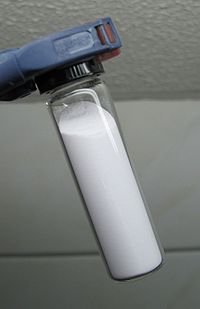- Cerium oxalate
-
Cerium oxalate 
 Cerium(III) oxalateOther namesCerium3+ oxalate
Cerium(III) oxalateOther namesCerium3+ oxalateIdentifiers CAS number 15750-47-7  , 139-42-4 (hydrate)
, 139-42-4 (hydrate) 
PubChem 8762 ATC code A04 Properties Molecular formula C6Ce2O12 Molar mass 544.29 g mol−1 Appearance White crystals Melting point Decomposes
Solubility in water Slightly soluble Hazards R-phrases R21/22 S-phrases S24/25 Main hazards Harmful (Xn) NFPA 704  oxalate (verify) (what is:
oxalate (verify) (what is:  /
/ ?)
?)
Except where noted otherwise, data are given for materials in their standard state (at 25 °C, 100 kPa)Infobox references Cerium oxalate is the inorganic cerium salt of oxalic acid. It is a white crystalline solid with the chemical formula of Ce2(C2O4)3. It may be formed by the reaction of oxalic acid and cerium(III) oxide.
Cerium oxalate is used as an antiemetic.
Cerium Oxalate has been identified as part of the invisible ink that was used by Stasi operatives during the Cold War[1].
Toxicity
Cerium oxalate irritates skin and mucous membranes, and is a strong irritant to eyes. If it gets into the eyes, there is a danger of severe eye injury.
Cerium salts increase the blood coagulation rate, and exposure to cerium salts can cause sensitivity to heat.
Oxalates are corrosive to tissue and are powerful irritants. They have a caustic effect on the linings of the digestive tracts and can cause kidney damage.
See also
References
Antiemetics (A04) 5-HT3 Antagonists Alosetron • Azasetron • Bemesetron • Cilansetron • Clozapine • Dazopride • Dolasetron • Granisetron • Lerisetron • Metoclopramide • Mianserin • Mirtazapine • Olanzapine • Ondansetron • Palonosetron • Ramosetron • Ricasetron • Tropisetron • ZatosetronCB1 Agonists (Cannabinoids) D2/D3 Antagonists H1 Antagonists (Antihistamines) mACh Antagonists (Anticholinergics) NK1 Antagonists Others Categories:- Cerium compounds
- Oxalates
- Antiemetics
Wikimedia Foundation. 2010.

